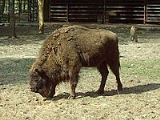
Caucasian Wisent
Encyclopedia
The Caucasian Wisent was a subspecies of Wisent
that inhabited the Caucasus Mountains
of Eastern Europe
.
It was hunted by the Caspian Tiger
and the Asiatic Lion
(until 10th century) in the Caucasus
, as well as other predators such as wolves and bear
s.
. After that human settlement in the mountains intensified and the range of the Caucasian wisent became reduced to about one tenth of its original range at the end of the 19th century. In the 1860s the population numbered still about 2000, but was reduced to only 500-600 in 1917, and only 50 in 1921. Local poaching continued and in 1927, the three last Caucasian bison were killed .
 Only one Caucasian bison bull is known to have been in captivity. This bull, named Kaukasus, was born in the Caucasus Mountains in 1907 and brought to Germany in 1908 where it lived until 26 February 1925. While in captivity it bred with cows from the Lowland subspecies Bison bonasus bonasus. Thus it became one of the 12 ancestors of the present Lowland-Caucasian breeding line of the European wisent pedigree book.
Only one Caucasian bison bull is known to have been in captivity. This bull, named Kaukasus, was born in the Caucasus Mountains in 1907 and brought to Germany in 1908 where it lived until 26 February 1925. While in captivity it bred with cows from the Lowland subspecies Bison bonasus bonasus. Thus it became one of the 12 ancestors of the present Lowland-Caucasian breeding line of the European wisent pedigree book.
hybrids were released into the Caucasian
Biosphere Reserve and later in 1959 in the Nalchik Forestry Game Management Unit (Kabardino-Balkariya). Later some pure-blood wisent of the Lowland-Caucasian breeding line were released there to form a single mixed herd together with the hybrids. In 2000, these hybrids are described as a different (although questionable) subspecies, the Highland bison Bison bonasus montanus .
Wisent
The wisent , Bison bonasus, also known as the European bison or European wood bison, is a species of Eurasian bison. It is the heaviest surviving land animal in Europe; a typical wisent is about long, not counting a tail of long, and tall. Weight typically can range from , with an occasional big...
that inhabited the Caucasus Mountains
Caucasus Mountains
The Caucasus Mountains is a mountain system in Eurasia between the Black Sea and the Caspian Sea in the Caucasus region .The Caucasus Mountains includes:* the Greater Caucasus Mountain Range and* the Lesser Caucasus Mountains....
of Eastern Europe
Eastern Europe
Eastern Europe is the eastern part of Europe. The term has widely disparate geopolitical, geographical, cultural and socioeconomic readings, which makes it highly context-dependent and even volatile, and there are "almost as many definitions of Eastern Europe as there are scholars of the region"...
.
It was hunted by the Caspian Tiger
Caspian Tiger
The Caspian tiger, also known as the Turan tiger and Hyrcanian tiger, is an extinct tiger subspecies that has been recorded in the wild until the early 1970s, and used to inhabit the sparse forest habitats and riverine corridors west and south of the Caspian Sea, from Turkey, Iran and west through...
and the Asiatic Lion
Asiatic Lion
The Asiatic lion also known as the Indian lion, Persian lion and Eurasian Lion is a subspecies of lion. The only place in the wild where the lion is found is in the Gir Forest of Gujarat, India...
(until 10th century) in the Caucasus
Caucasus
The Caucasus, also Caucas or Caucasia , is a geopolitical region at the border of Europe and Asia, and situated between the Black and the Caspian sea...
, as well as other predators such as wolves and bear
Bear
Bears are mammals of the family Ursidae. Bears are classified as caniforms, or doglike carnivorans, with the pinnipeds being their closest living relatives. Although there are only eight living species of bear, they are widespread, appearing in a wide variety of habitats throughout the Northern...
s.
Decline and extinction
In the 17th century, the Caucasian wisent still populated a large area of the Western CaucasusWestern Caucasus
The Western Caucasus is a western region of the Caucasus in Southern Russia, extending from the Black Sea to Mount Elbrus.-World Heritage Site:...
. After that human settlement in the mountains intensified and the range of the Caucasian wisent became reduced to about one tenth of its original range at the end of the 19th century. In the 1860s the population numbered still about 2000, but was reduced to only 500-600 in 1917, and only 50 in 1921. Local poaching continued and in 1927, the three last Caucasian bison were killed .
Hybrid survivors

Wisent reintroductions in the Caucasus
In 1940, a group of wisent-American bisonAmerican Bison
The American bison , also commonly known as the American buffalo, is a North American species of bison that once roamed the grasslands of North America in massive herds...
hybrids were released into the Caucasian
Biosphere Reserve and later in 1959 in the Nalchik Forestry Game Management Unit (Kabardino-Balkariya). Later some pure-blood wisent of the Lowland-Caucasian breeding line were released there to form a single mixed herd together with the hybrids. In 2000, these hybrids are described as a different (although questionable) subspecies, the Highland bison Bison bonasus montanus .

